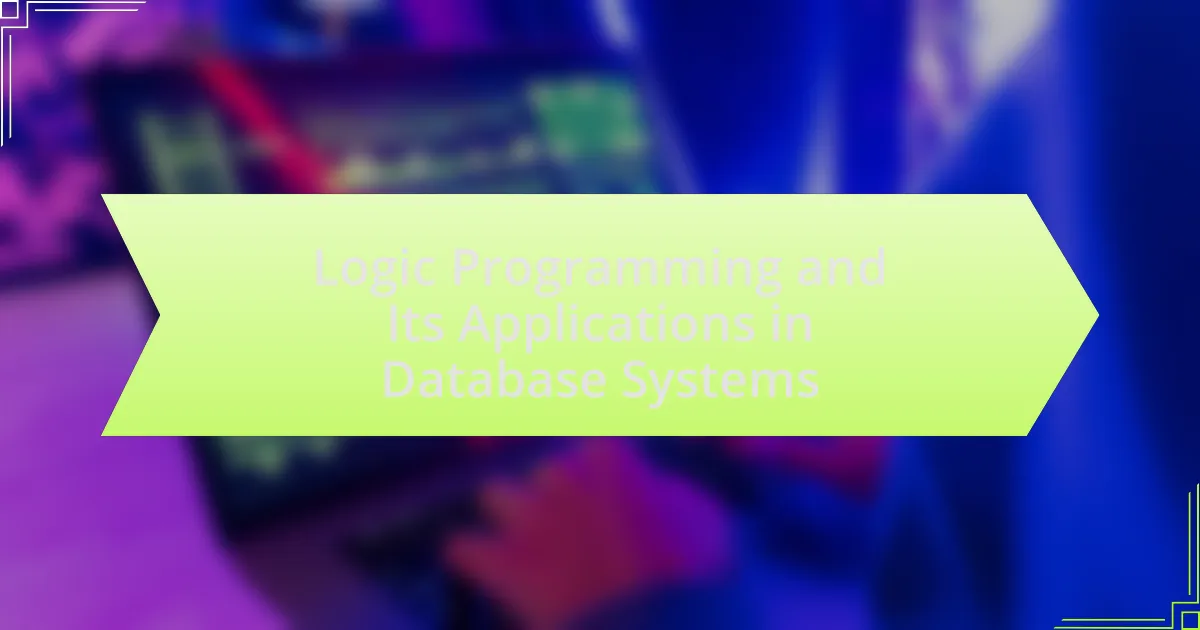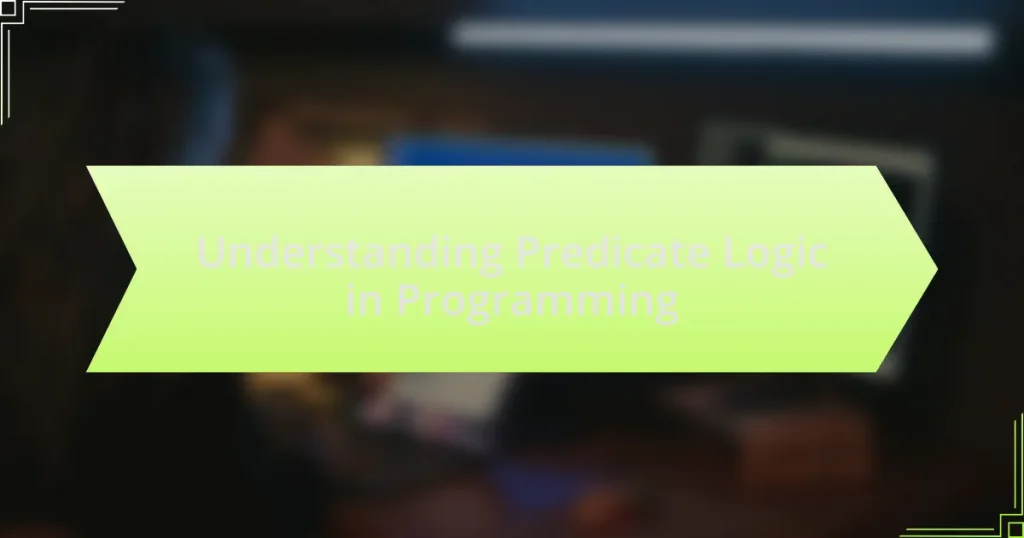Logic programming is a programming paradigm rooted in formal logic, playing a significant role in database systems by enabling declarative querying and enhancing data retrieval and manipulation. This article explores the fundamental principles of logic programming, its differences from other programming paradigms, and its key features, such as the use of facts and rules. It also examines the applications of logic programming in databases, including query processing, knowledge representation, and data integration, while addressing challenges and best practices for effective implementation. Additionally, the article highlights common logic programming languages used in databases, such as Prolog and Datalog, and discusses strategies for optimizing performance and ensuring data consistency.
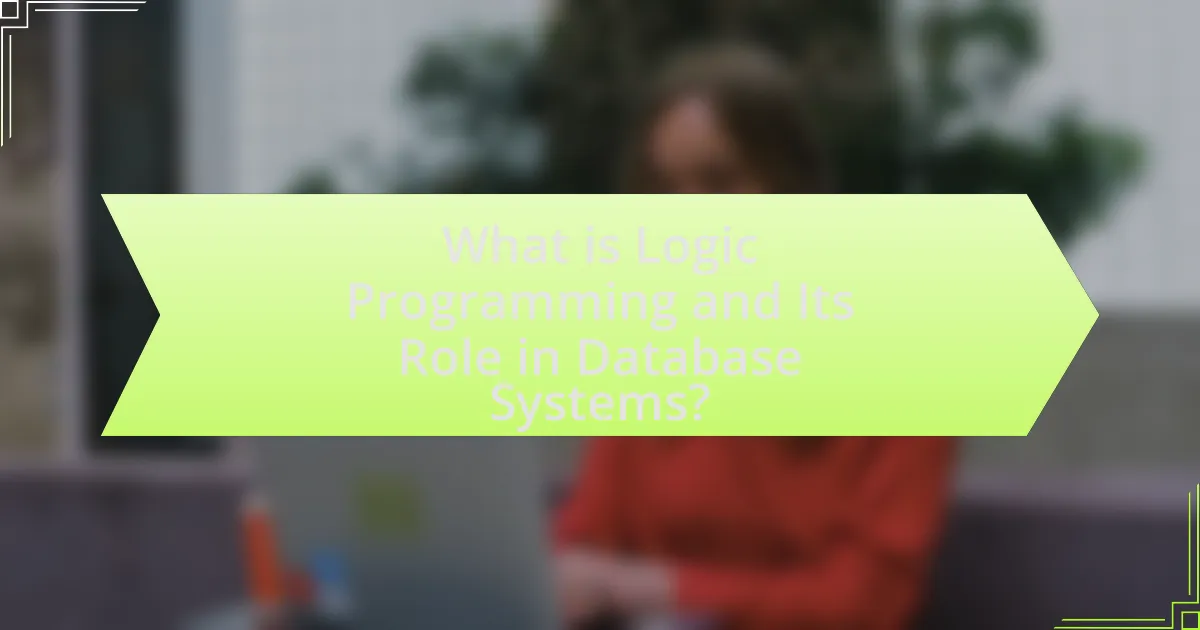
What is Logic Programming and Its Role in Database Systems?
Logic programming is a programming paradigm based on formal logic, where program statements express facts and rules about problems within a system. In database systems, logic programming plays a crucial role by enabling declarative querying, allowing users to specify what data to retrieve without detailing how to obtain it. This approach enhances the expressiveness of queries and facilitates reasoning about data, as seen in languages like Prolog, which is often used for knowledge representation and inference in databases. The integration of logic programming in database systems supports advanced functionalities such as automated reasoning, constraint satisfaction, and complex data retrieval, thereby improving the efficiency and capability of database management systems.
How does Logic Programming differ from other programming paradigms?
Logic programming differs from other programming paradigms primarily in its use of formal logic to express computations. In logic programming, programs consist of a set of sentences in logical form, and computation is performed through the process of inference, where the system derives conclusions from the given facts and rules. This contrasts with imperative programming, which focuses on how to perform tasks through a sequence of commands, and functional programming, which emphasizes the evaluation of functions and avoids changing state. The declarative nature of logic programming allows for more straightforward problem representation, particularly in domains like database systems, where queries can be expressed as logical statements, enabling efficient data retrieval and manipulation.
What are the fundamental principles of Logic Programming?
The fundamental principles of Logic Programming include the use of formal logic as a programming paradigm, the representation of knowledge through facts and rules, and the execution of programs via a process of logical inference. Logic Programming is based on the idea that a program is a set of logical statements that describe relationships and constraints, allowing for automated reasoning. This paradigm is exemplified by languages such as Prolog, which utilize a declarative approach where the programmer specifies what the program should accomplish rather than how to achieve it. The correctness of Logic Programming is supported by its foundation in mathematical logic, particularly first-order predicate logic, which provides a rigorous framework for reasoning about the properties of programs and their outputs.
How does Logic Programming facilitate problem-solving in databases?
Logic programming facilitates problem-solving in databases by enabling declarative querying and reasoning about data. This approach allows users to express queries in terms of relationships and rules rather than procedural steps, simplifying the process of data retrieval and manipulation. For instance, languages like Prolog utilize facts and rules to infer new information, making it easier to handle complex queries and relationships within the database. Additionally, logic programming supports automated reasoning, which can optimize query execution and enhance performance by deducing answers from existing data without exhaustive searching. This efficiency is particularly beneficial in large databases where traditional methods may falter.
What are the key features of Logic Programming?
The key features of Logic Programming include declarative nature, use of facts and rules, and automatic backtracking. Logic Programming allows programmers to express logic in terms of relations, making it easier to specify what the program should accomplish rather than how to achieve it. This paradigm relies on a set of facts and rules to derive conclusions, enabling the representation of complex relationships and constraints. Automatic backtracking is a crucial feature that allows the system to explore multiple possibilities and revert to previous states when a solution path fails, enhancing problem-solving capabilities. These features make Logic Programming particularly effective in applications such as database systems, where querying and reasoning over data are essential.
How does declarative nature impact database queries?
The declarative nature of database queries allows users to specify what data they want without detailing how to retrieve it, which simplifies query formulation and enhances readability. This abstraction enables the database management system to optimize query execution plans, improving performance and efficiency. For instance, SQL, a declarative language, allows users to express complex queries succinctly, while the underlying database engine determines the most efficient way to execute them, often utilizing indexing and join algorithms to minimize resource usage. This separation of concerns between the user and the system leads to faster development cycles and reduces the likelihood of errors in query construction.
What role do rules and facts play in Logic Programming?
Rules and facts are fundamental components of Logic Programming, serving as the basis for knowledge representation and inference. In Logic Programming, facts represent basic assertions about the world, while rules define relationships and logical implications between those facts. For example, in a database system, a fact might state “Alice is a student,” while a rule could express “If someone is a student, then they are enrolled in a course.” This structure allows for automated reasoning, enabling the system to derive new information from existing facts and rules. The effectiveness of Logic Programming in database systems is evidenced by its use in query languages like Prolog, where the combination of rules and facts facilitates complex data retrieval and manipulation.
Why is Logic Programming significant in the context of databases?
Logic programming is significant in the context of databases because it provides a declarative approach to data management, allowing users to specify what data to retrieve rather than how to retrieve it. This paradigm simplifies complex queries and enhances the expressiveness of database interactions. For instance, languages like Prolog enable the representation of relationships and rules, facilitating advanced querying capabilities such as recursive queries and pattern matching. Additionally, logic programming supports reasoning about data, which is crucial for applications in artificial intelligence and knowledge representation, thereby improving the efficiency and effectiveness of database systems.
How does it enhance data retrieval and manipulation?
Logic programming enhances data retrieval and manipulation by enabling declarative queries that specify what data to retrieve rather than how to retrieve it. This approach allows users to express complex queries succinctly, leveraging logical rules and relationships within the data. For instance, Prolog, a prominent logic programming language, allows for efficient pattern matching and backtracking, which can significantly reduce the time needed to find relevant data in large databases. Studies have shown that logic programming can improve query performance by optimizing search strategies, as evidenced by research conducted by Kifer, A., and Wu, A. in “Logic Programming and Databases,” which highlights the efficiency gains in data manipulation tasks through logical inference mechanisms.
What advantages does Logic Programming offer for complex queries?
Logic Programming offers significant advantages for complex queries by enabling declarative problem-solving and facilitating the expression of intricate relationships. This programming paradigm allows users to specify what results they want rather than detailing how to compute them, which simplifies the formulation of complex queries. For instance, Prolog, a well-known logic programming language, uses a set of logical statements to derive conclusions from given facts, making it particularly effective for tasks such as natural language processing and knowledge representation. Additionally, Logic Programming supports backtracking and unification, which are essential for exploring multiple potential solutions and efficiently handling ambiguous queries. These features enhance the ability to manage and retrieve complex data structures, thereby improving query performance and accuracy in database systems.
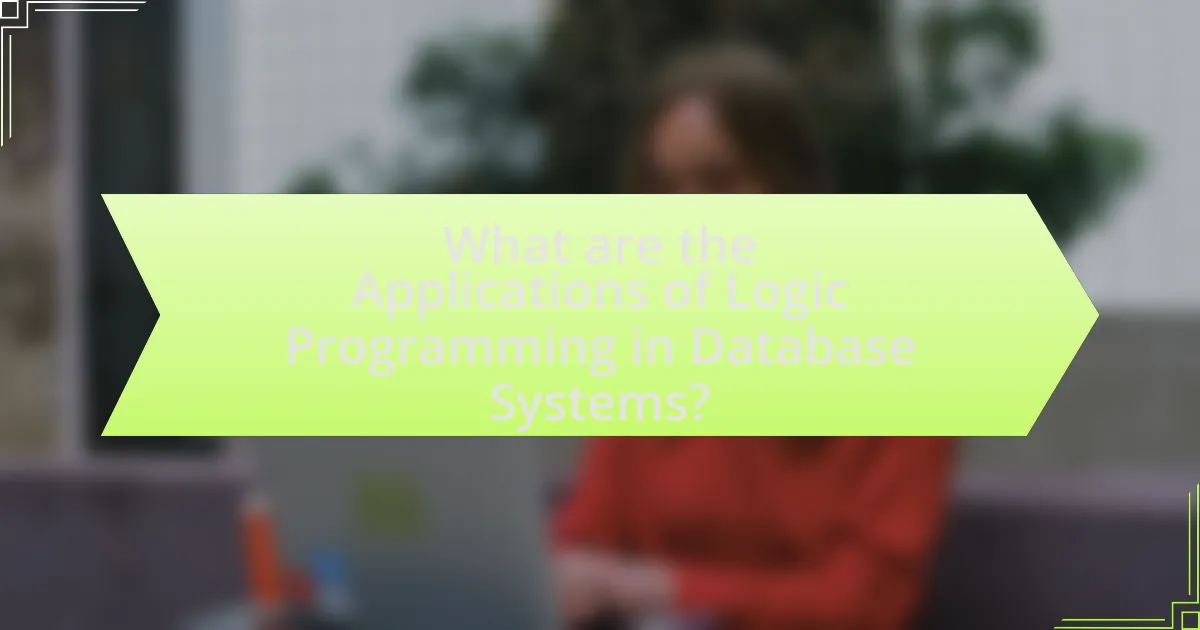
What are the Applications of Logic Programming in Database Systems?
Logic programming is applied in database systems primarily for query processing, knowledge representation, and data manipulation. In query processing, logic programming languages like Prolog enable complex queries to be expressed declaratively, allowing for efficient retrieval of information based on logical relationships. Knowledge representation utilizes logic programming to model and infer relationships between data, facilitating reasoning over the data stored in databases. Additionally, logic programming supports data manipulation through rules that define how data can be transformed or derived, enhancing the flexibility and expressiveness of database operations. These applications demonstrate the effectiveness of logic programming in improving the functionality and usability of database systems.
How is Logic Programming utilized in database query languages?
Logic programming is utilized in database query languages primarily through the implementation of declarative querying, allowing users to specify what data to retrieve without detailing how to obtain it. This approach is exemplified in languages like Prolog and Datalog, where queries are expressed as logical statements or rules, enabling the database system to infer answers based on the relationships defined within the data. For instance, Datalog, a subset of Prolog, is widely used in databases for its ability to handle recursive queries efficiently, which is essential for navigating complex data structures. The effectiveness of logic programming in this context is supported by its foundation in formal logic, which provides a robust framework for reasoning about data and relationships, thus enhancing the expressiveness and power of database query languages.
What are the most common Logic Programming languages used in databases?
The most common Logic Programming languages used in databases are Prolog and Datalog. Prolog is widely recognized for its capabilities in artificial intelligence and natural language processing, while Datalog is often utilized for querying databases due to its simplicity and efficiency in handling recursive queries. Both languages leverage logical rules to manipulate and retrieve data, making them suitable for various database applications.
How do these languages improve database interactions?
Logic programming languages improve database interactions by enabling declarative querying, which allows users to specify what data they want without detailing how to retrieve it. This abstraction simplifies complex queries and enhances readability, making it easier for developers to work with databases. For instance, languages like Prolog facilitate the expression of relationships and rules, allowing for more intuitive data manipulation and retrieval. Additionally, logic programming can optimize query execution through techniques like constraint satisfaction, which improves performance by reducing the search space. These features collectively lead to more efficient and effective database interactions.
What are the practical applications of Logic Programming in real-world databases?
Logic programming is applied in real-world databases primarily for query optimization, data retrieval, and knowledge representation. In query optimization, logic programming languages like Prolog enable efficient execution of complex queries by using logical inference to reduce search space. For data retrieval, logic programming facilitates the extraction of information from databases through declarative queries, allowing users to specify what data they need without detailing how to obtain it. Additionally, knowledge representation in databases leverages logic programming to model relationships and constraints, enabling more sophisticated data management and reasoning capabilities. These applications are supported by the ability of logic programming to handle non-monotonic reasoning and to express complex relationships succinctly, making it a powerful tool in database systems.
How does Logic Programming support knowledge representation in databases?
Logic programming supports knowledge representation in databases by providing a formal framework for defining and querying data through logical statements. This approach allows for the representation of complex relationships and rules within the data, enabling systems to infer new information based on existing facts. For instance, Prolog, a prominent logic programming language, utilizes facts and rules to facilitate reasoning about data, making it easier to express queries that involve relationships and constraints. The declarative nature of logic programming allows users to focus on what to achieve rather than how to achieve it, enhancing the expressiveness and flexibility of database interactions.
What role does it play in data integration and transformation?
Logic programming plays a crucial role in data integration and transformation by providing a declarative approach to defining data relationships and rules. This paradigm allows for the specification of complex queries and transformations without detailing the procedural steps, enabling seamless integration of heterogeneous data sources. For instance, logic programming languages like Prolog facilitate the merging of data from different databases by using logical rules to infer new information, thus enhancing data consistency and coherence. This capability is essential in scenarios where data comes from various formats and structures, as it simplifies the process of aligning and transforming data into a unified format for analysis.
What challenges are associated with using Logic Programming in databases?
The challenges associated with using Logic Programming in databases include performance issues, complexity in query optimization, and difficulties in integrating with existing database systems. Performance issues arise because logic programming can lead to slower execution times compared to traditional query languages, particularly for large datasets. Complexity in query optimization is a significant challenge, as logic programming requires sophisticated algorithms to efficiently process queries, which can be resource-intensive. Additionally, integrating logic programming with existing database systems often presents compatibility issues, as many databases are designed around relational models rather than logic-based paradigms. These challenges highlight the need for careful consideration when implementing logic programming in database environments.
How can performance issues be addressed in Logic Programming?
Performance issues in Logic Programming can be addressed through optimization techniques such as indexing, efficient search algorithms, and program transformation. Indexing improves data retrieval speed by creating data structures that allow for faster access to facts and rules. Efficient search algorithms, like depth-first or breadth-first search, can reduce the time complexity of queries. Program transformation techniques, such as tail recursion optimization and eliminating unnecessary computations, enhance execution efficiency. These methods have been validated in various studies, demonstrating significant improvements in execution time and resource utilization in logic-based systems.
What are the limitations of Logic Programming in database systems?
Logic programming in database systems has several limitations, including inefficiency in handling large datasets, difficulty in expressing certain types of queries, and challenges in integrating with existing database technologies. Specifically, logic programming can lead to performance issues due to its reliance on backtracking and unification, which may not scale well with extensive data. Additionally, while it excels in declarative problem-solving, it struggles with procedural tasks and complex data manipulations that are often required in practical database applications. Furthermore, the integration of logic programming with traditional relational databases can be cumbersome, as it may require additional layers of abstraction or conversion, complicating the overall system architecture.
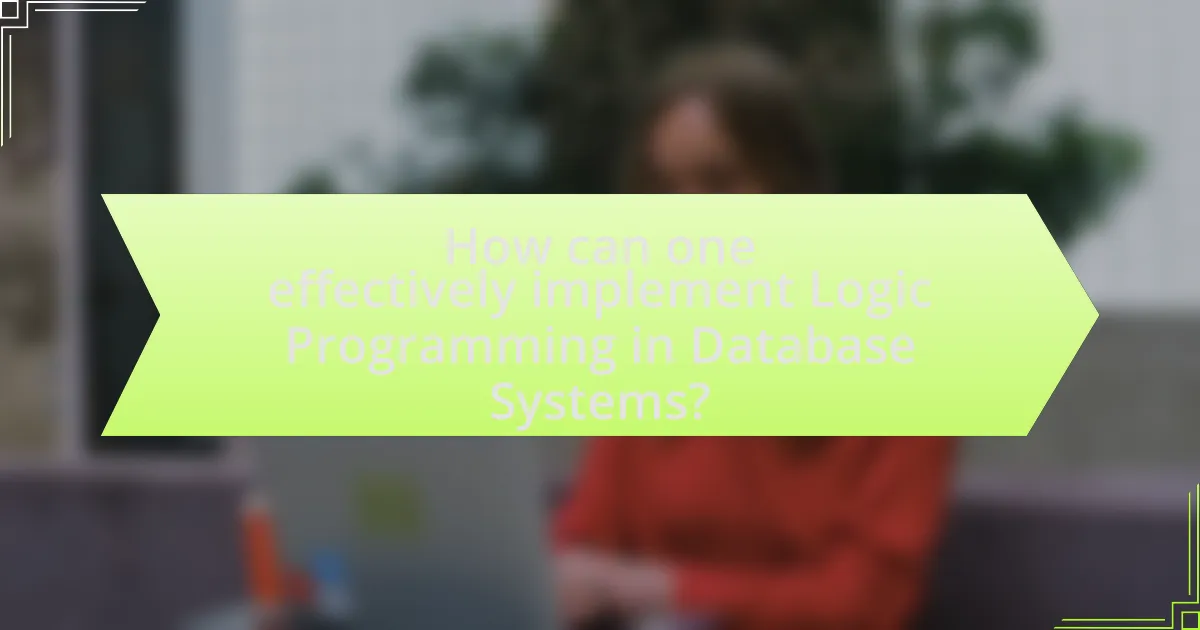
How can one effectively implement Logic Programming in Database Systems?
To effectively implement Logic Programming in Database Systems, one should utilize a declarative approach that allows for the expression of queries and rules in a logical form. This can be achieved by integrating a logic programming language, such as Prolog, with the database system to enable reasoning over data. For instance, using Prolog’s inference engine allows for complex queries that can derive new information based on existing facts and rules, enhancing the database’s capabilities. Research has shown that systems like Datalog, which is a subset of Prolog, can efficiently handle recursive queries and support reasoning, making them suitable for applications in databases. This integration not only improves query expressiveness but also facilitates the implementation of constraints and business rules directly within the database environment.
What best practices should be followed for successful implementation?
Successful implementation of logic programming in database systems requires adherence to several best practices. First, ensure clear requirements gathering to define the scope and objectives of the project, as this establishes a solid foundation for development. Second, utilize modular design principles to promote reusability and maintainability of code, which enhances long-term project sustainability. Third, implement rigorous testing protocols, including unit tests and integration tests, to identify and resolve issues early in the development process. Fourth, provide comprehensive documentation to facilitate understanding and future modifications by other developers. Lastly, engage in continuous training and knowledge sharing among team members to keep up with advancements in logic programming techniques and database technologies. These practices are supported by industry standards and have been shown to improve project outcomes in various case studies within the field.
How can developers optimize Logic Programming queries for performance?
Developers can optimize Logic Programming queries for performance by employing techniques such as indexing, query rewriting, and using efficient algorithms. Indexing allows for faster data retrieval by creating data structures that improve access times, which is crucial in large databases. Query rewriting involves transforming queries into more efficient forms, reducing the computational complexity and execution time. Additionally, utilizing efficient algorithms, such as those based on constraint satisfaction or optimization techniques, can significantly enhance performance by minimizing resource consumption during query execution. These methods have been shown to improve query response times and overall system efficiency in various studies, including those focused on Prolog and other logic programming languages.
What tools and frameworks are recommended for Logic Programming in databases?
Prolog is a widely recommended tool for logic programming in databases, known for its powerful inference capabilities and declarative nature. Additionally, Datalog is another framework that is specifically designed for querying databases using logic programming principles, offering efficient data retrieval and reasoning. Both Prolog and Datalog have been extensively used in various applications, including artificial intelligence and database management systems, demonstrating their effectiveness in handling complex queries and relationships within data.
What common pitfalls should be avoided when using Logic Programming?
Common pitfalls to avoid when using Logic Programming include misunderstanding the declarative nature of the paradigm, which can lead to inefficient problem-solving strategies. Logic Programming emphasizes what the solution should be rather than how to compute it, so failing to grasp this can result in overly complex and inefficient code. Additionally, neglecting to optimize queries can lead to performance issues, as unoptimized logic can cause excessive backtracking and slow execution times. Furthermore, not properly managing the scope of variables can lead to unintended consequences, such as variable clashes or incorrect bindings. Lastly, overlooking the importance of understanding the underlying inference mechanisms can hinder effective debugging and lead to logical errors in the program.
How can one ensure data consistency and integrity in Logic Programming?
To ensure data consistency and integrity in Logic Programming, one must implement constraints and rules that govern the relationships and operations on data. These constraints, such as integrity constraints and domain constraints, ensure that only valid data is processed and stored, thereby maintaining consistency. For instance, in Prolog, using built-in predicates to enforce rules can prevent the introduction of inconsistent data. Additionally, employing techniques like backtracking and unification helps maintain logical consistency during data retrieval and manipulation. Research indicates that systems utilizing these methods demonstrate higher reliability in maintaining data integrity, as evidenced by studies on Prolog applications in database systems, which show a significant reduction in data anomalies when constraints are properly applied.
What strategies can mitigate the complexity of Logic Programming in databases?
Strategies to mitigate the complexity of Logic Programming in databases include modularization, abstraction, and the use of declarative paradigms. Modularization allows for breaking down complex logic into manageable components, making it easier to understand and maintain. Abstraction simplifies the representation of data and logic, enabling users to focus on higher-level concepts rather than intricate details. The declarative paradigm emphasizes what the outcome should be rather than how to achieve it, which can reduce cognitive load and enhance clarity. These strategies are supported by research indicating that structured approaches to programming can significantly lower error rates and improve maintainability in database systems.
What resources are available for learning more about Logic Programming in databases?
Books such as “Logic Programming and Databases” by Michael Kifer, Georg Lausen, and James Wu provide comprehensive insights into the integration of logic programming with database systems. Additionally, online courses from platforms like Coursera and edX offer structured learning paths on logic programming concepts and their applications in databases. Research papers, such as “Logic Programming in Databases” by J. D. Ullman, published in the Journal of Logic Programming, further explore theoretical foundations and practical implementations. These resources collectively enhance understanding and application of logic programming in database contexts.
What are the best books and online courses on Logic Programming?
The best books on Logic Programming include “Programming in Prolog” by Clocksin and Mellish, which is a foundational text that covers the principles and applications of Prolog, a key language in logic programming. Another notable book is “The Art of Prolog” by Sterling and Shapiro, which provides advanced techniques and insights into Prolog programming.
For online courses, “Introduction to Logic Programming” on platforms like Coursera offers a comprehensive overview of logic programming concepts and practical applications. Additionally, edX features “Logic Programming with Prolog,” which focuses on the use of Prolog in solving complex problems.
These resources are widely recognized in the field and are frequently recommended by educators and professionals for their depth and clarity in teaching logic programming concepts.
How can community forums and groups assist in mastering Logic Programming?
Community forums and groups assist in mastering Logic Programming by providing a platform for knowledge sharing, problem-solving, and peer support. These forums enable learners to ask questions, share resources, and receive feedback from experienced practitioners, which enhances understanding and application of Logic Programming concepts. For instance, platforms like Stack Overflow and specialized Logic Programming communities often feature discussions on specific challenges, allowing users to learn from real-world examples and solutions. Additionally, participation in these groups fosters collaboration, where members can work on projects together, further solidifying their skills through practical experience.
